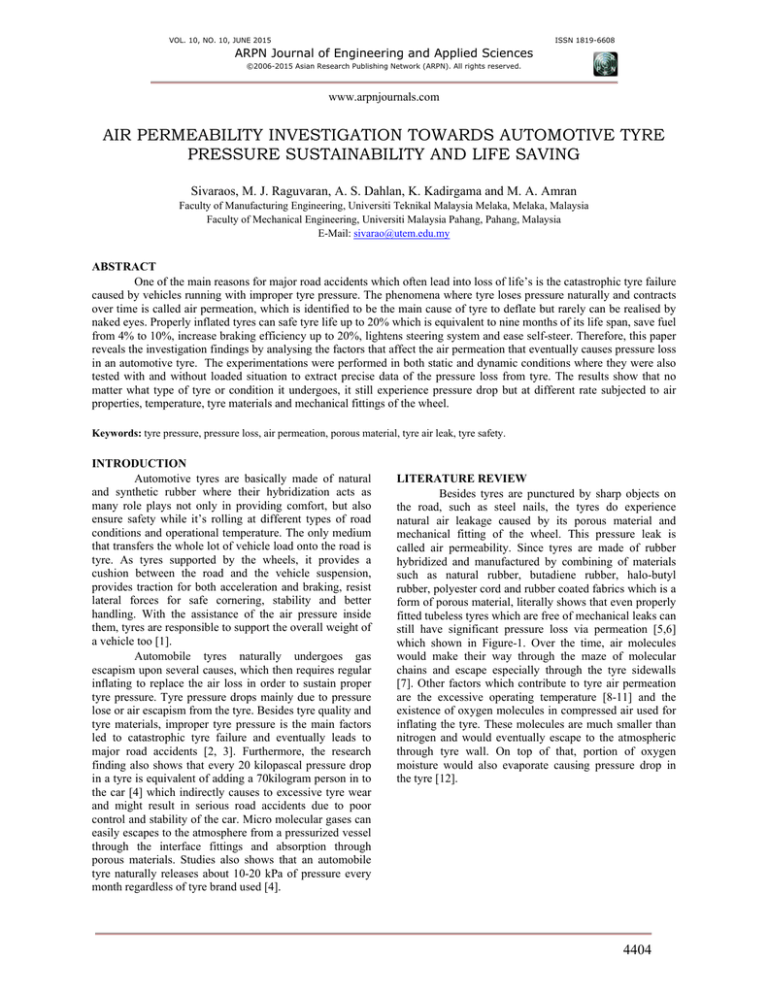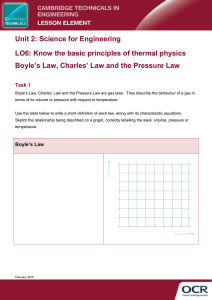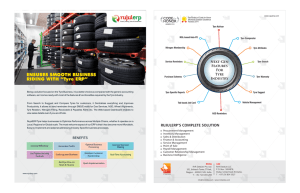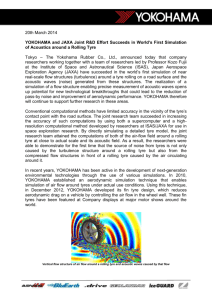
VOL. 10, NO. 10, JUNE 2015
ISSN 1819-6608
ARPN Journal of Engineering and Applied Sciences
©2006-2015 Asian Research Publishing Network (ARPN). All rights reserved.
www.arpnjournals.com
AIR PERMEABILITY INVESTIGATION TOWARDS AUTOMOTIVE TYRE
PRESSURE SUSTAINABILITY AND LIFE SAVING
Sivaraos, M. J. Raguvaran, A. S. Dahlan, K. Kadirgama and M. A. Amran
Faculty of Manufacturing Engineering, Universiti Teknikal Malaysia Melaka, Melaka, Malaysia
Faculty of Mechanical Engineering, Universiti Malaysia Pahang, Pahang, Malaysia
E-Mail: sivarao@utem.edu.my
ABSTRACT
One of the main reasons for major road accidents which often lead into loss of life’s is the catastrophic tyre failure
caused by vehicles running with improper tyre pressure. The phenomena where tyre loses pressure naturally and contracts
over time is called air permeation, which is identified to be the main cause of tyre to deflate but rarely can be realised by
naked eyes. Properly inflated tyres can safe tyre life up to 20% which is equivalent to nine months of its life span, save fuel
from 4% to 10%, increase braking efficiency up to 20%, lightens steering system and ease self-steer. Therefore, this paper
reveals the investigation findings by analysing the factors that affect the air permeation that eventually causes pressure loss
in an automotive tyre. The experimentations were performed in both static and dynamic conditions where they were also
tested with and without loaded situation to extract precise data of the pressure loss from tyre. The results show that no
matter what type of tyre or condition it undergoes, it still experience pressure drop but at different rate subjected to air
properties, temperature, tyre materials and mechanical fittings of the wheel.
Keywords: tyre pressure, pressure loss, air permeation, porous material, tyre air leak, tyre safety.
INTRODUCTION
Automotive tyres are basically made of natural
and synthetic rubber where their hybridization acts as
many role plays not only in providing comfort, but also
ensure safety while it’s rolling at different types of road
conditions and operational temperature. The only medium
that transfers the whole lot of vehicle load onto the road is
tyre. As tyres supported by the wheels, it provides a
cushion between the road and the vehicle suspension,
provides traction for both acceleration and braking, resist
lateral forces for safe cornering, stability and better
handling. With the assistance of the air pressure inside
them, tyres are responsible to support the overall weight of
a vehicle too [1].
Automobile tyres naturally undergoes gas
escapism upon several causes, which then requires regular
inflating to replace the air loss in order to sustain proper
tyre pressure. Tyre pressure drops mainly due to pressure
lose or air escapism from the tyre. Besides tyre quality and
tyre materials, improper tyre pressure is the main factors
led to catastrophic tyre failure and eventually leads to
major road accidents [2, 3]. Furthermore, the research
finding also shows that every 20 kilopascal pressure drop
in a tyre is equivalent of adding a 70kilogram person in to
the car [4] which indirectly causes to excessive tyre wear
and might result in serious road accidents due to poor
control and stability of the car. Micro molecular gases can
easily escapes to the atmosphere from a pressurized vessel
through the interface fittings and absorption through
porous materials. Studies also shows that an automobile
tyre naturally releases about 10-20 kPa of pressure every
month regardless of tyre brand used [4].
LITERATURE REVIEW
Besides tyres are punctured by sharp objects on
the road, such as steel nails, the tyres do experience
natural air leakage caused by its porous material and
mechanical fitting of the wheel. This pressure leak is
called air permeability. Since tyres are made of rubber
hybridized and manufactured by combining of materials
such as natural rubber, butadiene rubber, halo-butyl
rubber, polyester cord and rubber coated fabrics which is a
form of porous material, literally shows that even properly
fitted tubeless tyres which are free of mechanical leaks can
still have significant pressure loss via permeation [5,6]
which shown in Figure-1. Over the time, air molecules
would make their way through the maze of molecular
chains and escape especially through the tyre sidewalls
[7]. Other factors which contribute to tyre air permeation
are the excessive operating temperature [8-11] and the
existence of oxygen molecules in compressed air used for
inflating the tyre. These molecules are much smaller than
nitrogen and would eventually escape to the atmospheric
through tyre wall. On top of that, portion of oxygen
moisture would also evaporate causing pressure drop in
the tyre [12].
4404
VOL. 10, NO. 10, JUNE 2015
ISSN 1819-6608
ARPN Journal of Engineering and Applied Sciences
©2006-2015 Asian Research Publishing Network (ARPN). All rights reserved.
www.arpnjournals.com
Figure-1. Molecule permeability in the rubber compound.
Even though most tyres look the same, but they
are not when comes to its detail structures, particularly
layers of liners. Most tyre manufacturers use “Butyl-Inner
Layer” to improve the ability to retain best of its air
pressure [13]. The permeability, Q is the product of mean
diffusion coefficient, D and a function, S related to the
solubility of the penetrant gas in the polymer; can be
derived by equation (1):
Q=DxS
(1)
The Solubility value S and the diffusivity value
Dis proportional to tyre operating temperature, then the
permeability Q would relatively increase with the rise of
tyre temperature. The molecules shown as M in Figure-1,
solubilizes at inner surface of tyre and finally diffuses
through the rubber compound and evaporates through the
tyre outer surface to atmospheric [14].
Temperature which promotes air permeability
On average, automobile tyre will lose seven to 14
kPa of air pressure per month in cool climate and more
upon warmer months due to the air permeability behaviour
of tyre materials which responds differently with
temperature [7]. The tyre operating conditions subjected to
cyclic deformations generating possible hysteresis to the
spinning kinematics [15] and the energy loss due to this
phenomenon consequently influences the coefficient of
friction and the tyre temperature [16, 17]. Therefore, the
heat is generated from the result of friction with the road
surface when the rubber structure is under deformed
condition [18] and this phenomenon ultimately result in
increasing the tyre temperature.
Figure-2. The tyre pressure loss operation cycle upon
excessive heat.
Figure-2 reveals that, as the heat increases due to
increased flexing on the sidewall of the tyre, it will
proportionally increase the porosity resulting worse
permeability. Therefore, this proves that a hotter tyre is
more permeable and tends to experience greater pressure
loses [12]. Moreover, excessive heat is accumulated inside
the tyre once the vehicle is fully loaded and travel at
higher speed. On a continuous driving, the tyre will reach
its stagnant point where the temperature is brought to stop
which is also called as “Saturation Temperature”, and the
maximum allowed temperature for most tyres are limited
to 125°C and would gradually decrease to 20°C within 10
minutes of rest [19].
Figure-3
witnesses
the
excessive
heat
concentration which takes place at the shoulder and
sidewall of the tyre [20, 21] being subjected to load, acts
as an absorber where it attracts heat more than other
region in tyres during dynamic condition. The common
tyre sidewall thickness is about 3 to 4 mm as compared to
15 to 20mm of its crown thickness [13].
4405
VOL. 10, NO. 10, JUNE 2015
ISSN 1819-6608
ARPN Journal of Engineering and Applied Sciences
©2006-2015 Asian Research Publishing Network (ARPN). All rights reserved.
www.arpnjournals.com
Pressure leak through mechanical fittings
Both the inflating valve and rim flange can be
corroded over the time due the oxygen contact at the
internal and external part of them [23]. This is clearly
shown in Figure-5, where the rough surfaces on the rim
flanges and tyre beads might not be sealed properly
causing additional air leaks. On the other hand, tiny spots
of corrosion on rim would not allow the valve seat to be
mounted properly on the rim valve seat and this situation
worsens air escapism which caused pressure drop in tyre.
Figure-3. Thermal-imaging at different tyre pressure
condition.
Properties of inflated air
Automotive tyres are usually inflated with
compressed air available at gas/fuel stations. Basically,
compressed atmospheric air contains Nitrogen (78%),
Oxygen (21%), Argon (0.9%), and miscellaneous gases
(0.1%) [22]. Since rubber is formed of porous material and
not 100% impermeable, the pressurized air inside the tyre
will seek equilibrium state with the atmospheric pressure
outside the tyre boundary. Oxygen molecules are much
smaller and humidified compared to Nitrogen. Thus,
Figure-4 shows how oxygen molecules filled into the tyre
will migrate in a faster rate through the tyre materials
especially at sidewalls (75%), around the tyre bead (15%)
and even through the valve stem (10%) of air leak [22].
Figure-5. Corroded rim flange and valve.
METHODOLOGY
In order to measure and analyse the natural
pressure drop of a tyre, two different ways were organized
which is; static-unloaded and dynamic-loaded condition to
study the deflation rate in both respective conditions. The
tyres used for this were of the same widely
commercialised (xx) brand with the aspect ratio
205/55R16 in similar conditions.
Static pressure test - unloaded condition
Wheel assembly with a brand new tyre and valve
stem, mounted on a test rig as shown in Figure-6. The tyre
was inflated with compressed air at 230kPa without any
rotation, contact, or load applied to it and kept in a closed
room with its room temperature of 25°C.
Figure-4. Permeability of oxygen and nitrogen molecules
through tyre sidewalls.
4406
VOL. 10, NO. 10, JUNE 2015
ISSN 1819-6608
ARPN Journal of Engineering and Applied Sciences
©2006-2015 Asian Research Publishing Network (ARPN). All rights reserved.
www.arpnjournals.com
RESULT AND DISCUSSIONS
Static-unloaded tyre test
The observed Static-Unloaded Tyre Test is
tabulated in Table-1. Subsequently, Figure-8 shows the
plot where the pressure drop trend can be monitored.
Table-1. Observed pressure for static-unloaded tyre.
Figure-6. Static pressure test for unloaded tyre.
Month
Pressure (kPa)
1
230
2
227
3
223
4
220
5
217
The pressure drop of the tyre were measured and
recorded every one month using pressure gauge exactly
from the date the tyre was inflated and mounted on the rig.
This test was conducted for five months continuously
without any inflation.
Dynamic pressure testing - loaded condition
The tyres are also tested in a dynamic-loaded
condition to differentiate and evaluate the pressure drop in
both the condition. All the specification used during staticunloaded condition is maintained (new tyre and valve
stem) but the differences are that the tyre is fitted in a road
travelling car (Malaysian made Proton Perdana 2.0 litre,
V6) as shown in Figure-7 where it weights about a ametric
tonne. The tyres were initially inflated at 230kPa with
compressed air.
Figure-8. Pressure decrease over month.
The phenomena where the tyre experiences
pressure drop gradually from the first until fifth month are
represented in Figure-8, in which the data are tabulated in
Table-1. This shows that tyres experiences pressure drop
even at room temperature, without operating and load
added to it, but ata smaller scale due to air permeation. It
is also proven that a tyre with inflated air can permeates
faster compared to tyre with inflated pure Nitrogen [24].
To treat the problem analytically by calculation, a few
simplifying assumptions have been considered:
a)
Figure-7. Dynamic-loaded tyre test on a vehicle.
For this condition, only one out of four tyres was
randomly chosen, namely front right tyre to be observed.
The pressure drop of the tyre was observed and recorded
of daily interval for every month using pressure gauge,
exactly from the date the tyre was inflated and fitted on the
vehicle. This test was conducted for five continuous
months without any inflation. Temperatures of the tyres
were also observed with thermocouple.
The inflated air contains only 80% of Nitrogen and
20% Oxygen.
b) The tyre inner-casing material is composed of
Butyllayer with 1cm thickness.
c) The tyre is stored in ambient room temperature of
25°C.
d) The entire variables are at Standard Temperature and
Pressure (STP).
e) The permeability of Oxygen is:
PO2 = 4.6x10-13 cm3 (STP).cm at 25°C
cm2 .s. Pa
f) The permeability of Nitrogen is:
PN2 = 1.6x10-13 cm3 (STP).cm at 25°C
4407
VOL. 10, NO. 10, JUNE 2015
ISSN 1819-6608
ARPN Journal of Engineering and Applied Sciences
©2006-2015 Asian Research Publishing Network (ARPN). All rights reserved.
www.arpnjournals.com
cm2 .s. Pa
The tyre (interior) is inflated to ptotal interior = 230kPa
= 2.3x105Pa
N2 = 80% = 0.8
O2 = 20% = 0.2
cm2.s
The Atmospheric (exterior) pressure to pexterior = 1 bar
= 1x105Pa
N2 = 80% = 0.8
O2 = 20% = 0.2
∆pN2 = (2.3 – 1) x 0.8 = 1.2 bar = 1.04x105Pa
The flux of gas through the tyre casing per unit of time
and surface area, n ’’:
Figure-9. Tyre section measurements.
n ’’ = Pi xPi1 – Pi2
(2)
l
n ’’ = Pi ∆pN2
= 1.6 x 10-13 x1.04x105
l
1
= 1.66x10-8 cm3 (STP)
cm2.s
∆pO2 = (2.3 – 1) x 0.2 = 0.26 bar = 2.6x104Pa
n ’’ = Pi ∆pO2
= 4.6x10-13 x2.6x104
The gas flows through the tyre surface Aexchange, is
given by:
D 2 D 2
Aexchange 2 1 2 2 D1 d
2 2
(3)
632 2 406 2
Aexchange 2
2 632 205
2 2
= 11.8x103 cm2
l1
= 1.20x10-8 cm3 (STP)
cm2.s
Hence the total outward flux for inflation with air,
n ‘’total air is obtained by:
n ’’total air = n ’’N2 + n ’’O2
-8
-8
= 1.66x10 + 1.20x10
= 2.9x10-8 cm3 (STP)
cm2.s
Based from the above, it is clear that tyre which
has been inflated with air at 230kPa has the outward flux
inflation rate of:
( n ’’total air = 2.9x10-8 cm3 (STP)).
cm2.s
deflates more rapidly compared to tyres inflated with pure
Nitrogen at 230kPa which has the outward flux inflation
rate [24] of :
( n ’’total nitrogen = 1.3x10-8cm3 (STP))
While the volume, V is obtained by :
D 2 D 2
V 1 2 d
2
2
(4)
632 2 406 2
V
205
2
2
= 37.8x10-3 m3
As tm can be described as number of seconds in a
month, which is:
tm = 3600 seconds x 24 hour x 30 days
hour
day
month
= 2.6x106seconds
month
Therefore, the outward flux of gas (tyres inflated
with air) in a month can be estimated. Since, tyres inflated
with air which has the rate of outward flux inflation of;
n ’’total air = 2.9x10-8 cm3 (STP)
cm2.s
4408
VOL. 10, NO. 10, JUNE 2015
ISSN 1819-6608
ARPN Journal of Engineering and Applied Sciences
©2006-2015 Asian Research Publishing Network (ARPN). All rights reserved.
www.arpnjournals.com
= 3.9x10-2gmol
n totalair= n ’’totalairx Aexchange
(5)
= (2.9x10-8) x (11.8x103)
Therefore the final pressure, pfinal of the tyre after
1 month is given by:
= 3.4x10-4 cm3 (STP)
S
nmonth air = n total air .tm
(6)
pfinal = (moles air initial – moles air out) .R . T
V
(9)
= (3.507 – 3.9x10-2) x 8.31451 x 298.15
37.8x10-3
= (3.4x10-4) x (2.6x106)
= 884cm3 (STP)
= 2.27x105Pa
By using the Ideal Gas Law:
= 227kPa
p.V = n.R.T
(7)
and the volume of a mole Vm, of an ideal gas is given by:
Vm= 22.414
l
gmol
Consequently the number of moles,n of gas
initially contained inside the tyre casing can be obtained
by:
n, moles air initial = pinitial. V
R .T
From the analysis, it reflects that in the case of
tyre been inflated with air even at static unloaded tyre
condition, the internal pressure will still decrease about
3kPa or 1.3% over a month period and the pressure drop
rate might vary depends on the tyre size.
Dynamic-loaded tyre test
The observed Dynamic-loaded Tyre Test is
tabulated in Table-2. Subsequently, Figure-10 shows the
plot where the pressure drop trend can be monitored.
Table-2. Observed pressure for dynamic-loaded tyre.
where
Initial tyre pressure, pinitial = 2.3bar = 2.3x105Pa
Volume, V = 37.8x10-3 m3
Ideal or Gas constant, R = 8.3145 J
gmol. K
Temperature in Kelvin, T = 25°C + 273.15 =
298.15 K
As the values obtained above can be substituted
into the formula:
Month
Pressure (kPa)
Mileage (km)
1
230
0
2
210
464
3
195
575
4
182
690
5
165
1150
n, molesair initial = (2.3x105 )x(37.8x10-3)
(8.31451) x (298.15)
= 3.507 gmol
Thus, the number of moles lost from the tyre
casing in a month is obtained by:
Moles air out per month = n month air
Vm
= 884x10-3
22.414
(8)
Figure-10. Pressure decrease over month and mileage.
4409
VOL. 10, NO. 10, JUNE 2015
ISSN 1819-6608
ARPN Journal of Engineering and Applied Sciences
©2006-2015 Asian Research Publishing Network (ARPN). All rights reserved.
www.arpnjournals.com
The phenomena where the tyre experiences
pressure drop gradually from first up to fifth month in a
larger scale, losing 10-20kPa per month as the vehicle
travels more is represented in Figure-10 in which the data
are correlated in Table-2. During the initial stages of the
tyre operating condition, tyre temperature are noticed to be
rising gradually too and become static which can be
described as “Stagnation Point” at 44.70C for the front tyre
and 41.80C at rear tyre as observed in Figure-11. Front
tyres experience higher heat concentration due to the
excessive load from the car’s engine compartment as it is a
front-engine car. It is very obvious that pressure drops
more in a dynamic-loaded tyre test compared to static-
unloaded tyre test condition. This is mainly because of the
effect of operating temperature and load on the tyre. As
the inflation pressure decreases, the temperature will
increases since lower inflation pressure results in more
deformation in the tyre rubber surface. This situation
generally increases normal load on a tyre that eventually
increases elastic deformation and the total strain energy
density resulting in temperature rise [25] and therefore,
proportionally increases the porosity resulting worse
permeability which ultimately providing enough space for
air leakage over time.
Figure-11. Temperature variance of tyre over distance travelled (Initial stage).
CONCLUSIONS
In this research, the factors that affects the air
permeation that causes natural pressure loss to the tyre has
been critically investigated and it shows that a normal
passenger car tyre experience pressure drop both in staticunloaded and worse still during dynamic-loaded condition.
At static-unloaded tyre condition, the tyre pressure drops
mainly because of air permeation by means of inflating via
compressed air which have the properties of Oxygen
molecules but during dynamic-loaded condition; pressure
drops more due to increased air permeability upon
excessive operating temperature and with the presence of
load. Therefore, this research gives an important response
and valuable outcome in order to develop a reasonable
solution for tyre to retain its pressure and literally
minimizing the rate of air permeation which causes
pressure loss at any circumstances.
Nomenclature
kPa
psi
Q
D
S
l
M
O2
N2
STP
Kilopascal
pounds per square inch
Permeability
Coefficient of Diffusion
Solubility
Tyre Casing Material Thickness
Molecule
Oxygen
Nitrogen
Standard Temperature and Pressure
n ’’
Rate of outward flux inflation
4410
VOL. 10, NO. 10, JUNE 2015
ISSN 1819-6608
ARPN Journal of Engineering and Applied Sciences
©2006-2015 Asian Research Publishing Network (ARPN). All rights reserved.
www.arpnjournals.com
tm
A
p
V
Vm
n
R
T
Number of seconds in a month
Surface
Pressure
Volume
Volume of mole
Number of moles
Ideal or Gas constant
Temperature (°C)
ACKNOWLEDGEMENT
The authors/researchers would like to thank the
Ministry of Higher Education Malaysia for awarding a
Fundamental Research Grant Scheme [Grant number:
FRGS/1/2013/TK01/UTEM/03/1]. We are also highly
indebt to the Management of Universiti Teknikal Malaysia
Melaka, Centre for Research and Innovation Management,
and Manufacturing Engineering Faculty for their
continuous courage and support.
REFERENCES
[1] Haraguchi T. 2006. Trends in Rubber Parts for
Automobiles. Nippon GomuKyokaishi, the Society of
Rubber Industry, Japan, Japan Science and
Technology Information Aggregator-Electronic, JStage. (79): 103-116.
[2] Litchfield P.W., 2001. Tyres Pressure, University of
California, first ed., pp. 250-260.
[3] Andre Dosjoub and Claude Lescoffit. 1988. U.S.
Patent 4, 922, 984.
[4] Sivarao Anand T.J.S. and Warikh M. 2009.
Engineering of Tyre Pressure Controlling Device: An
Invention towards Successful Product Development.
International Journal of Basic and Applied Sciences
IJBAS-IJENS. 9(09): 45-48.
[5] Information on http://www.tarrc.co.uk.
[6] Coddington, D.M. 1979. Inflation Pressure Loss in
Tubeless Tyre - Effects of Tyre Size, Service and
Construction. Rubber Chemistry and Technology. 52:
905-919.
[7] Bridgestone Tyres 2006-2014. Can Air Leak into a
Tire by Bridgestone Commercial Truck Tires,
Bridgestone Americas Tire Operations, LLC.
[8] Tian Tang, Daniel Johnson, Robert E.Smith, Sergio
D. Felicelli. 2014. Numerical Evaluation of the
Temperature Field of Steady-State Rolling Tyres,
Appl. Math.Modell.38, pp.1622-1637.
[9] Cho J.R, Lee H.W., Jeong W.B., Jeong K.M. and Kim
K.W. 2013. Numerical Estimation of Rolling
Resistance and Temperature Distribution of 3-D
Periodic Patterned Tire. Int. J. Solids Struct. 50, pp.
86-96.
[10] Yeong-Jyh Lin and Sheng-Jye Hwang. 2004.
Temperature Prediction of Rolling Tyres by Computer
Simulation. Math. Comput. Simul. 67, pp. 235-249.
[11] Kazutaka Yokota, Eisei Higuchi and Masashi
Kitagawa. 2012. Estimation of the Tire Temperature
Distribution and Rolling Ressistance under Running
Conditions Including Environmental Factors. SAE.J.
01, pp. 0796-0807.
[12] Brian Basch. 2011. The Past, Present and Future of
Nitrogen Tire Inflation, Real World Application and
Acceptance of Nitrogen Commercial Success from
Passenger to Commercial Markets. Branick
Industries. pp. 3-13.
[13] Information on http://www.michelin.com.my.
[14] Tyler Gruber., Charles Herd., Paul Smith., and Steve
Crossley. 2012. Effects of Filler Morphology and
Loading on Tire Inner Permeability-A Computational
Study. Columbian Chemicals Company. pp. 1-21.
[15] FlavioFarroni, Ernesto Rocca. and Francesco
Timpone. 2013. A Full Scale Test Rig to Characterize
Pneumatic Tyre Mechanical Behaviour. International
Review of Mechanical Engineering (I.R.E.M.E). 7(5):
841-846.
[16] Allouis C., Amoresano A., Giordano D., Russo M.
and Timpone F. 2012. Measurement of the Thermal
Diffusivity of a Tire Compound by Means of Infrared
Optical Technique. International Review of
Mechanical Engineering (I.R.E.M.E). 6 (6): 11041108.
[17] Farroni F., Russo M., Russo R. and Timpone F. 2012.
Tyre – Road Interaction: Experimental Investigations
about the Friction Coefficient Dependence on Contact
Pressure, Road Roughness, Slide Velocity and
Temperature. Proceedings of the ASME 2012 11th
Biennial Conference on the Engineering System
Design and Analysis. 4: 521-529.
[18] Azman.
Abdullah,M.,
NoreffendyTamaldin,
Muhammad Khatib. Abdul Aziz, Ahmad Fadhil.
Munawar, and Mad Nasir. Ngadiman. 2013.
4411
VOL. 10, NO. 10, JUNE 2015
ISSN 1819-6608
ARPN Journal of Engineering and Applied Sciences
©2006-2015 Asian Research Publishing Network (ARPN). All rights reserved.
www.arpnjournals.com
Increasing the Tire Life Span By Means of Water
Cooling. International Journal of Mining, Metallurgy
and Mechanical Engineering (IJMMME). 1(1): 78-80.
[19] Kumho Tires. 2013. Tire Journal by Kumho Tires
Membership Magazine. (01): 1-21.
[20] Song T.S., Lee J.W., and Han J.Y. 1998. Rolling
Resistance of Tires-An Analysis of Heat Generation”,
SAE Technical Paper Series. 980225. pp. 1-5
[21] Huang M.X., Li Z. and Xia Y.M, 2012. The Interior
Temperature Distribution Measurement in a Rolling
Tire. Proceedings of 2012 International Conference
on Mechanical Engineering and Material Science
(MEMS). pp. 311-313.
[22] Chris Lein. 2011. Nitrogen in Tires. Get Nitrogen
Institute.
[23] Osokogwu. U. and Oghenekaro.E. 2012. Evaluation
of Corrosion Inhibitors Effectiveness in Oilfield
Production Operations” International Journal of
Scientific and Technology Research. 1(4): 19-23.
[24] Luca Sabino., Giovanni Naldi. and PieroPelloni.
2000. Tyre Inflation with De-Oxygenated Air.
Mechanical Engineering Department, Faculty of
Engineering, University of Bologna, Degree Thesis,
Chapter III and IV, Academic Year 1999/2000, pp.
63-75
[25] Dahlan A.S. 2011. Design and Analysis towards
Novel Tire Inflation System. MSc. Thesis, Faculty of
Manufacturing Engineering, Universiti Teknikal
Malaysia Melaka (UTeM).
4412





